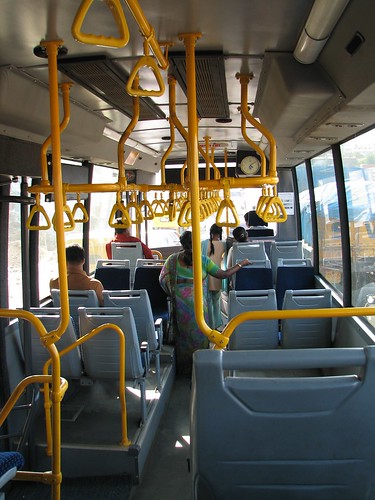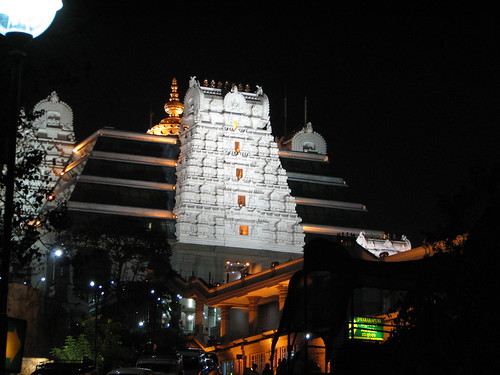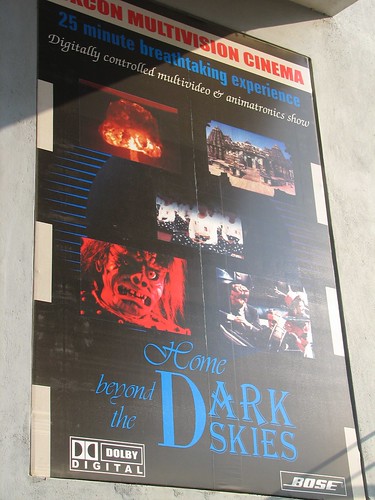A Visit to the Holy Beacon - ISKCON, BangaloreThe introduction of
intra-city air-conditioned Volvo buses across various routes in Bangalore covering all vantage points is one the first effort of its kind in the country. This has been running for close to one year or so in the city but I never got an opportunity to use this facility. The coverage of a long distance to reach ISKCON temple, which is located in Rajajinagar, a locality pretty far off from my residential complex offered me this chance, few days back.
I was impressed by the bus facility and these are exactly similar to the ones that I have used in Europe. Even the conductor uses an electronic ticketing gadget, a welcome change from the regular hand signed, tickets placed in the pockets of a tattered leather bag. The only disappointing and unsatisfying feature to my notice was the cost of the ticket, which is pretty high for the regular commuters [i.e. vendors, construction site workers, maids, even humble students as the monthly/daily passes are not valid in these buses.]. The bus was effectively vacant for most part of the journey and by the time we reached the destination it was just my friend and myself. Does this really serve the purpose, as the public transport, be it simple regular buses or the A/C buses should logically cater to regular commuters. But on the contrary these A/C buses just cater to a certain segment of the society, those who can afford. This can serve as an example of the tunnel effect, which was discussed elaborately by Amartya Sen, in the recently concluded NASSCOM meet at Mumbai.

Digression again, back to the topic then, so let me get back to my ISKCON impressions. It was a unique experience for me. A noteworthy place to visit in Bangalore. The
ISKCON [International Society for Krishna Consciousness] temple dedicated to Lord Krishna is situated on the top of a small hillock.
We had to climb several steps to reach the sanctorum but that was not very difficult. First of all, we went up few steps to reach a place where we deposited our footwear and camera [no photography is allowed inside the temple] in the safe custody of the temple authorities. As per Hindu traditions and customs, any form of footwear has to be strictly removed before one enters the temple premises. The temple is like an small amusement park in terms of the maintenance and the peripheral physical infrastruture, and I sincerely apologize if that sounds sacrilegious. Before climbing the marble stairs to the entrance, the visitors and devotees are called for to wash their feet at a washing station. After that starts a human chain meandering through metal railings, similar to those that one would find at an amusement park or while entering through the gates of any open-air concert with a metal detector gate for security check and inspection.
Even if it was a normal day sans any fesitivities, still there was a pretty big crowd. Another interesting thing to notice, are the numerous placards warning of pickpockets. The massive crowd of visitors had no problem pushing up close against us, whether it was intentional or un-intentional, I am not aware of that. But it was not the body-to-body kind of close that you find in a typical crowded bus in India. All the while, a bell tolled somewhere ahead in the line and a recording droned on:
Hare Krishna Hare Krishna, Krishna Krishna Hare Hare, Hare Rama Hare Rama, Rama Rama Hare Hare.... There were people of all shades, all age groups and in different moods and there are few foreigners in the crowd too as we climbed through 108 marble steps. So the queue wasn't really for anything in particular and it wound its way through a series of shrines. If I remember it correctly, first there was Lord Narasimha's temple and then Lord Venkateswara's temple which finally ended in an open courtyard from where the entire city's skyline looked splendiferous. The main temple, is large and impressive and few pillars/structures are bedecked with gold. This is the Krishna temple and has a huge hall where devotees and visitors, sit in peace after offering their prayers.

While
Ju was sitting here, I walked to an information counter and started gathering information on Akshaya Patra Project about which I had heard and read lots in newspaper and magazine.
Akshaya Patra Project is the mid-day meal scheme, where school children in government-run schools are given free lunches in Karnataka, Uttar Pradesh, Rajasthan and Orissa. The reason and rational behind this program is that food could lure children to attend school. Only when a child’s stomach is satisfied, s/he would show some postive inclination for studies in schools in rural or semi-urban areas.
"Akshaya Patra" means the container that never gets empty. It is the container Lord Krishna gave to Draupadi, before the Pandavas started their journey into the forest. The Lord wanted his cousins to eat well and never struggle for food, which finds a parallel in ISKCON's scheme. The entire program is managed by some really smart, experienced and educated people who hail from some of the top engineering schools in India like
IIT Chennai, REC Warangal, REC Nagpur, IISc Bangalore, etc. Few among them have even worked in business houses both in India and the US, before dedicating themselves to this altruistic activity. I did a simple calculation to realise that an amount close to 30-32 Lakhs Rupees is spent each day for this Akshaya Patra Project across the various centers in India. Assume that each meal costs around Rs. 6 and there are close to 5,00,000+ children fed daily by this selfless initiative and so this amounts to figure stated above. On enquiry, I learnt that the funding for this comes from software/tech companies, philanthropists, business houses, voluntary donations, and also from the various centers of ISKCON spread across the globe.
This main temple winds its way through a bookstore before culminating in a food stall. There are a number of counters where you can buy books, trinkets, religious icons, posters, postcards, sweets, fruits, savory food, jewelry, incense sticks, dresses, saris, t-shirts, etc. There is also an amphitheatre, equipped with the latest state of the art by
BOSE and
DOLBY Digital, but unfortunately there were no shows the day, we were there because of some repair and maintainence work. The food stall is a center of attraction and offers a wide variety of mouth watery eatables such as jalebis, samosas, dhokla, chaat, dahi vaada, etc. At few vantage points there are donation counters where one can donate money (credit and debit cards are accepted, although this sign was posted above a drop-box).

The food court goes over a pedestrain footbridge back to the parking lot where a man with a stack of dried banyan leaves shaped like bowls hands each one a leaf, and another man serves spoonful of hot yellow sticky rice pudding called prasadam into it. It's an offering, and one should eat it with good spirit and appreciation sitting on the limestone benches that borders a pool of placid water there. Birds chirping
chee chee and a cacophony of sounds provide the natural music at this sunset hour.
Was it fear of God, spirituality, or just an invitation to see a new place that drew me to this place, ISKCON. Whatever may be the reason, it gave me an inexplicable confidence that one can pass thorough the vicissitudesof human life in this world without any fear and falterings. I recked little of time during this gratifying experience. I don’t know how I can satifactorily explain the mystery of serenity and divine within-ness of this place, with its independence of any temporal sense. By this time it was twilight, and somewhere in the recesses of my mind, I was aware that in the world below, nights come with suprising quickness of traffic jams, yet I felt no concern about that matter.
I stood there and took some pictures from outside the temple premises. Then within a few minutes
Ju and I returned to the humdrum of daily life.
We got stuck in a traffic imbroglio and it was life back on normal turf again.
Keep reading and remain conneted.
Labels: business, culture, friendship, India, learning, life, travel












